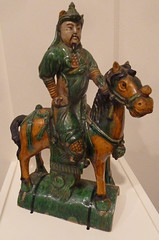In that odd lull between end-of-semester grading and final exam grading, I finally got around to reading that interlibrary loan book that was due last Friday, Kenneth Swope’s A Dragon’s Head and a Serpent’s Tail: Ming China and the First Great East Asian War, 1592-1598 (U Oklahoma Press, 2009). As a world historian, I’m always looking for good world history, especially transnational history that touches on my field, and the Hideyoshi invasions of Korea and the Korean-Ming Chinese defense is a fantastic case study … in something. The only full-length study I’ve read on them is Turnbull’s, though there clearly is more scholarship out there (See the comments) than I’ve run across. I’d love a good, recent book in print that I could assign students (Turnbull’s out of print and, well, Turnbull), and I’d love to see these wars taken seriously as transnational history.
 Swope’s book isn’t bad, certainly, and it’s particularly interesting for the argument he’s making about late Ming military capacity (much, much better in quality and quantity than they get credit for) and leadership (maybe time to stop assigning Huang’s 1587…), as well as a much more complete picture of the military action and Korean agency in the military and political process. As a military history, perhaps even falling into the “New Military History” category, it’s quite a substantial work. From the conclusion:
Swope’s book isn’t bad, certainly, and it’s particularly interesting for the argument he’s making about late Ming military capacity (much, much better in quality and quantity than they get credit for) and leadership (maybe time to stop assigning Huang’s 1587…), as well as a much more complete picture of the military action and Korean agency in the military and political process. As a military history, perhaps even falling into the “New Military History” category, it’s quite a substantial work. From the conclusion:
In describing the “modernization” of European armies, William McNeill discusses such factors as civilian control of supply lines, regular payment of the soldiers with tax money, the differentitation of military units, and the tactical coordination of cavalry, artillery, and infantry. Of course, all of these characteristics can be found in the armies involved in the First Great East Asian War. Scholars also deem the role of repetitive drilling and standardization of training techniques crucial to creating modern military forces. The introductio of Ming general Qi Jiguang’s training manuals to Korea was of much importance. Drawing upon Qi’s model, the Koreans later created their won martial-arts treatise, the Muye dobo tongii which includes a sword form attributed to Li Rusong. The allies also participated in sophisticated amphibious operations and in joint land-sea attacks. Even the use of maps and the creation of joint-planning operations by the allies predates such activity in Europe by some two centuries. (299)
That said, I have some qualms about assigning it to students. First, it’s overwhelmingly military history, so that the cultural and political and economic elements of the history are secondary and the pre/post-war are handled in a fairly perfunctory fashion (though some good points are made, especially about the Japan-Korea relationship). That’s fine if you’re interested in military history (and I’ll certainly recommend it to my military historian colleague, and any students so inclined) but it’s not really the kind of history I’m trying to present to my students, mostly, especially in 300-page doses. A book that boiled the military history down to about two chapters in the middle of serious pre/post analysis would be more like what I’m looking for as a textbook…
As history writing, it’s not the best model for students, either. The only times the term ‘revisionist’ is used, it’s used pejoratively, despite the fact that this work (like all argumentative histories) is revisionist towards previous scholarship, etc. “Historiography” also comes up, but only in conjunction with partisan perspectives. There are some lovely discussions of moments where the Chinese, Korean, and/or Japanese sources differ on facts (lots of figures, too) but no sense of how to resolve such differences, or even if resolving them is worthwhile. Then there’s the vast majority of the rest of the book, which presents a straightforward factual narrative with no discussion of sources outside of the endnotes. There are one or two exceptions where personal diaries of witnesses are invoked, but no analysis of credibility; they’re just witnesses.
Military history often is a kind of transnational history, though not one that world history people have given much credit or credence to (and vice-versa). Swope has a nice touch with the diplomatic history around the war (though his focus on China means much more sophisticated institutional history on the “Allied” side) and handles cultural issues well, though not deeply.
Swope does point in the direction of some of what yet needs to be done on the war, including a careful consideration of the role of captured Koreans in Japan as forced labor, the integration of Chinese (and some Japanese) who stayed in Korea, the post-war prisoner exchanges (which continued through about 1605 [I had to return the book this afternoon, so I can’t check]). Naturally, I noticed all the migration stuff. I’m sure there was more…
2 Comments